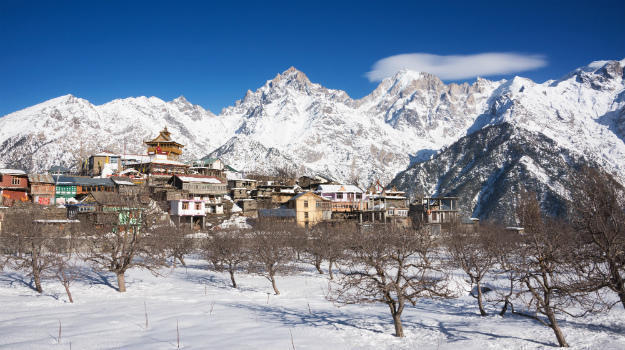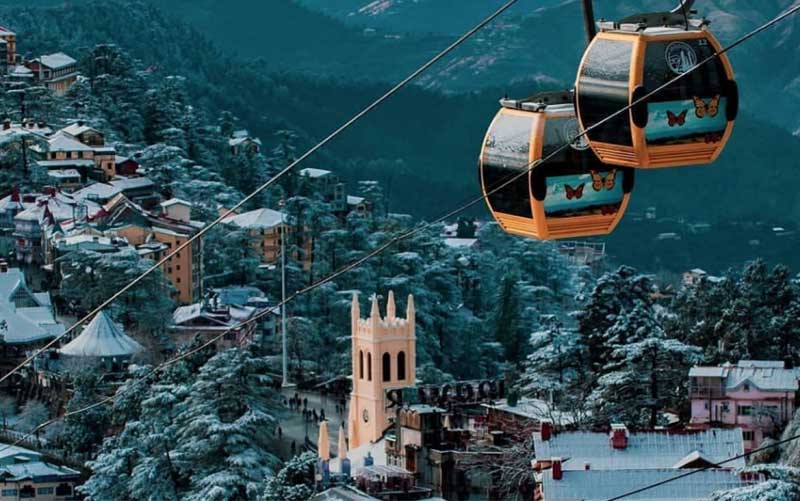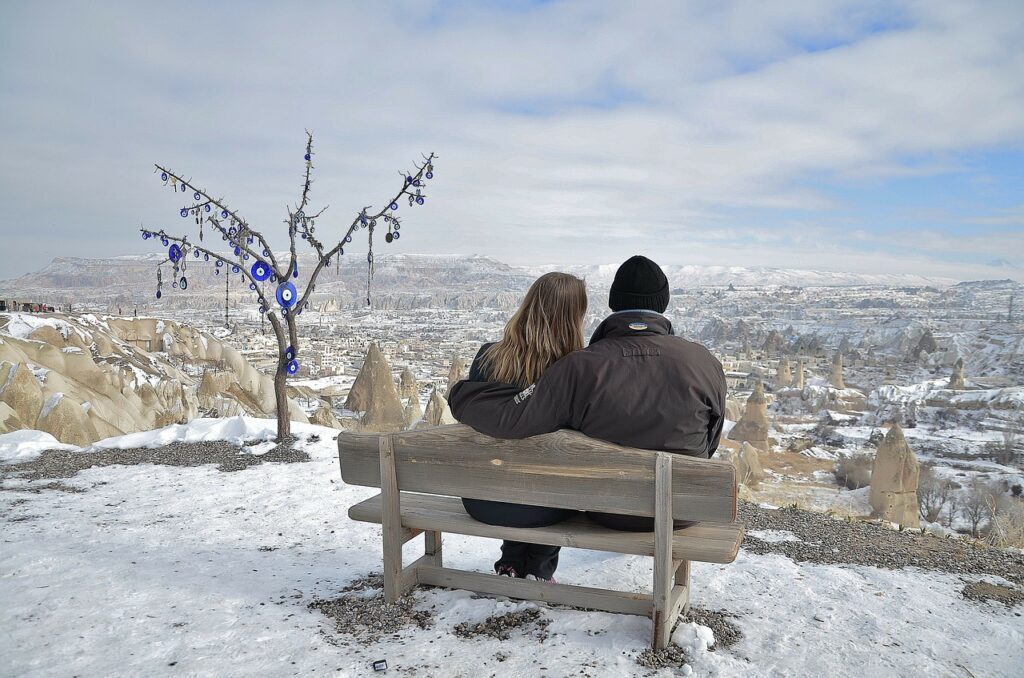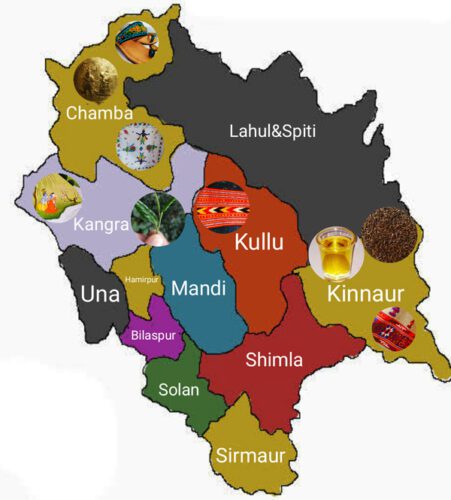Best Time to Visit Spiti Valley in Summer
In the summer, this beautiful valley sheds a white blanket of snow covering it over the cold, dark winter months (March to June). Tourists who want to visit Spiti but want to avoid dealing with the crowds typically go there from Shimla.
There isn’t a single cloud in the sky, and the weather is exactly right, so you can relax and enjoy the gorgeous surroundings. Even if it may be cold at night, camping is still a great option since the night sky is filled with many stars.
Duration of summer: March through June are summer in Spiti.
Average Temperature: The average daytime high temperature is about 15 degrees Celsius, and the average nighttime low temperature is about 6 degrees Celsius.
Pros & Cons of Visiting in Summer
Pros
- In June, people can start taking the Manali route, which is beautiful but takes longer to get to the Spiti Valley. Watch the weather, and wait to take this route until you know the passes are passable.
- If you want to escape the crowds and find peace, the beginning of March is a great time to go to Spiti. Since the Manali route opens in June, fewer people will be there. Feel free to enjoy the peace.
- Because of the weather, summer is often the best time of year. You can see more of this beautiful area on these sunny, clear days.
- Since the weather will be nice, you can go outside, hiking, biking, night camping, and more.
- During the summer, every hotel and inn is open to guests. This gives you a wide range of choices based on your tastes and budget.
Cons
- There will be parts of the road in bad shape, so if you have to travel in the first week of March, plan. As the snow melts, it could make slippery the ground and break up the ice in some places.
- The nights may seem much colder than usual for people who aren’t used to such low temperatures.
Routes to Reach Spiti in Summer
The best time to go to Spiti is between March and May. The best way to get there is through Shimla and Spiti. This path lets people get to the valley at any time of the year. The route starts in Shimla and goes through Narkanda, Rampur, Kalpa, Nako-Giu Village, Tabo Village, Dhankar, Pin Valley (Mud Village), and Kaza.
If your trip is in June, you can enter Spiti by crossing the pass from the Manali side. From Manali to Kaza, you would go from Manali to Solang Valley to Rohtang Pass to Gramphu to Batal to Chandratal to Kunzum Pass to Losar and then to Kaza.
Places to See During the Summer
Chandratal: People often call this lake “Moon Lake,” one of Spiti Valley’s most beautiful places. The huge brown mountains in the distance look almost unreal next to the still water’s gray, blue, and green colors.
Dhankar: Because of its beautiful lake, old fort, and 1200-year-old monastery, Dhankar has become a prominent place to visit.
Tabo: Tabo is one of the most interesting places in the area because it has a mysterious network of caves, a monastery that has been there for hundreds of years, and a stark, bleak landscape.
Hikkim: The world’s highest post office is in the town of Hikkim in the Spiti Valley. This is a big draw for tourists.
Komic: Komic is a must-see because it is thought to be the highest village in the world that can be reached by car.
Langza: The village of Langza is where people interested in fossils go. The huge golden statue of Lord Buddha that stands guard over the valleys is also a beautiful sight.
Fairs & Festivals in Summer
Tsheshu Festival (June): This lively event is called the Kye Chham Festival. Lamas wear masks of animals and birds and do the “devil dance” at this celebration to make the spirits happy and get their blessings for material success. Monasteries like Shashur, Tabo, Mane, and Gemur may have this festival.
Best Time to Visit Spiti Valley in Winter
Spiti gets a new layer of snow every year during the winter months, which turns the area into a beautiful winter wonderland. You will see the snow leopard’s poop marks all over frozen lakes, waterfalls, and snowy slopes. Spiti is a great place to visit in the winter if you want to go snow trekking, climb frozen waterfalls, and see the rare snow leopard.
There aren’t many people in the valley, which adds to the peace you can find there. During the colder months, you can only get to Spiti by taking the route that starts in Shimla. Because of the snow, you will be very alone, so you must mentally and physically prepare for a hard trek.
Duration of winter: Spiti’s long, cold winter lasts from October to February.
Average Temperature: 0 degrees Celsius during the day and -40 degrees Celsius at night.
Pros & Cons of Visiting in Winter Degrees.
Pros
- If you want to be alone in the mountains, the best time to go to Spiti is in the winter, when fewer people are there.
- If you want to feel like you’re in winter, plan your trip to the Spiti Valley for this time of year. You can go on winter hikes and even see real snowfall.
- People who are interested in nature might be able to see snow leopards.
Cons
- It can get very cold during the winter, and wind chills can be very low. It is very cold in Spiti during the winter, so people who need more preparation should stay away.
- Most places of business, like restaurants and motels, close for the season. Your best bet is to stay with a family. At this point, it doesn’t make sense to expect fancy comforts.
- The rooms at the remaining hotels and B&Bs will cost a lot of money. Prices for places to stay tend to be higher in the winter.
- Because of all the snow, many roads will be closed or in bad shape. These are dangerous because they are cold, the ground is soft, and they cross water. If you must travel during these months, give yourself a few extra days if the weather or something outside your control slows you down.
- Because of how cold it is, you should expect something other than running water. You’ll have to use outhouses, which are probably bone dry, and go many days without a shower.
- Now, the power goes out and goes up and down. You might find us near the kitchens or the campfires.
- Since there is no electricity in the valley, likely, the ATMs will not work.
- Due to the heavy snowfall, phone service will be very spotty. So, you should expect to be cut off for a while.
Routes to Reach Spiti in Winter
The only road that can be driven to Spiti in the winter is the one that goes through Shimla. The possible route begins in Shimla, goes through Narkanda, Rampur, Kalpa, Nako-Giu, Tabo, Dhankar, and Pin Valley, and ends in Kaza. At the moment, this is the only way to go.
Fairs & Festivals in Winter
Dechhang Festival: During December, one of the most popular events in Spiti takes place. There is local food, a bonfire, and live music and dance from the area at this lovely event.
Losar Festival is one of the most-attended events and marks the start of the Tibetan New Year. Everyone participates in the celebrations, from the biggest cities to the farthest monasteries. During these three days, there are processions, dances, musical performances, large bonfires, and prayer sessions.
Gochi Festival: For this interesting event to be remembered, February is set aside. Only families who had a son born in the previous calendar year are allowed to take part. On this day, dough and change, a drink made from rice, are given as sacrifices to the local gods.
Fagli Festival: This festival is held in early February, a week after Amavasya, to honor the angels called “Shikhara-Appa.” People believe that these angels were the ones who made the mountain range, and every year a festival is held to honor them. People decorate their homes with oil lamps, flowers, and bamboo, offering barley flour and buttermilk to the local gods as sacrifices.
Spiti Valley in Monsoon
Like Ladakh, Spiti is a dry, cold desert that doesn’t get much rain, even during the monsoon season. Still, it rains a lot on the Shimla side of the city, and the roads that lead to the city often need to be in better shape. You’ll have to cross several rivers along the path from Batal to Gramphoo.
The orange and brown leaves that cover the valley in the fall are beautiful. The nice days and cool nights make it easy to enjoy the valley’s natural beauty.
Duration of monsoon: People usually think that the monsoon season in Spiti lasts from July to September.
Average temperature: The average daytime temperature is about 10 degrees Celsius, and the average nighttime temperature is about 4 degrees Celsius (night).
Pros & Cons of Visiting in Monsoon
Pros
- Spiti doesn’t get a lot of rain, so you can go outside and enjoy the valley’s beauty without worrying about getting wet.
- The weather is nice and calm, making it a great time to spend outside.
Cons
- You should expect to be late getting to Spiti because of checkpoints, landslides, water crossings, and slippery roads. Since the rain has loosened the ground in some places, there is a chance of coming across shooting stones.
- Your clothes and other things you own might get ruined by the rain. Always keep them safe, and bring extras just in case.
- No matter how well you care for your car, it could break down anytime. Keep spare parts on hand at all times.
- At this time of year, many truckloads of apples are being shipped all over the country, which makes traffic more likely to be backed up.
Routes to Reach Spiti in Monsoon
People visiting Spiti Valley between July and September can choose between the Manali and Shimla routes.
On the way to Shimla, you can stop in Narkanda, Rampur, Kalpa, Nako-Giu Village, Tabo Village, Dhankar, Pin Valley (Mud Village), and Kaza.
From Manali, you have to go through Rohtang Pass and Gramphu, Batal, Chandratal, Kunzum Pass, Losar, and the Solang Valley to get to Kaza. This is the right way to go.
Places to See During Monsoon
Besides the usual tourist spots like Chandratal Lake, Komic, Hikkim, Dhankar, etc., you should visit the following places during the monsoon season.
- Nako Village: This town is known worldwide for its beautiful lake and monastery from the 11th century.
- Tabo Village: This charming neighborhood is known not only for its old houses but also for the well-known monastery that is inside one of them. Buddhists come from all over the world to show how grateful they are.
- Mudh Village:Mudh Village is in the beautiful Pin Valley and is surrounded by tall mountains. This makes it seem like a place that is far away and hard to reach
Fairs & Festivals in Monsoon
Ladarcha Festival: This historic event started as a place for people from rural parts of the state to sell their goods. Now, it’s more like a fair than anything else. During the third week of August, this festival takes place. Along with local dance groups, you can see amazing works of art, jewelry, organic food, handicrafts, and even yaks.
Tribal fair: People get very excited about this fair because it takes place on the same dates as India’s Independence Day (August 14–16). People from the area will bring food to share, and there will be bonfires, music, and dancing.
Gataur festival: In honor of the Deity Chaugayal, people dance the Chham and offer saur to a fire at this event. There are celebrations for a whole week. The holiday is held during the last full week of September.














